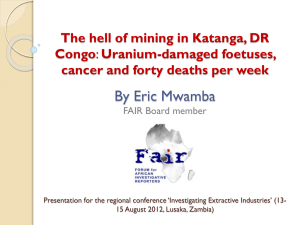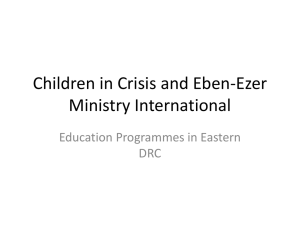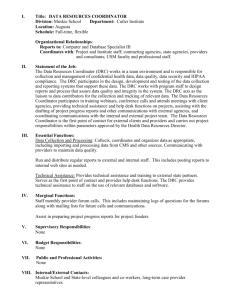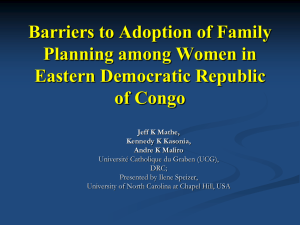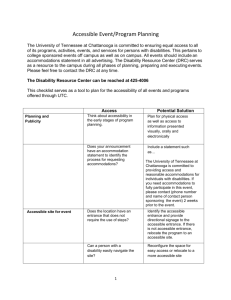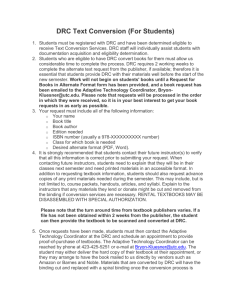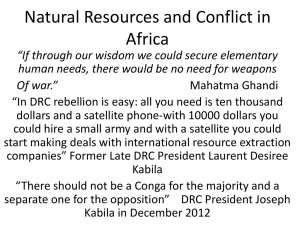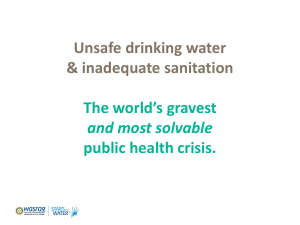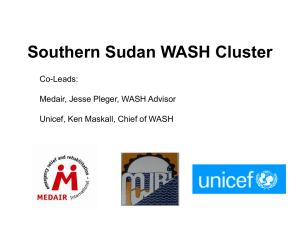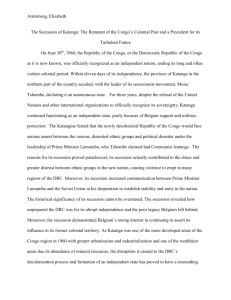Narratives
advertisement
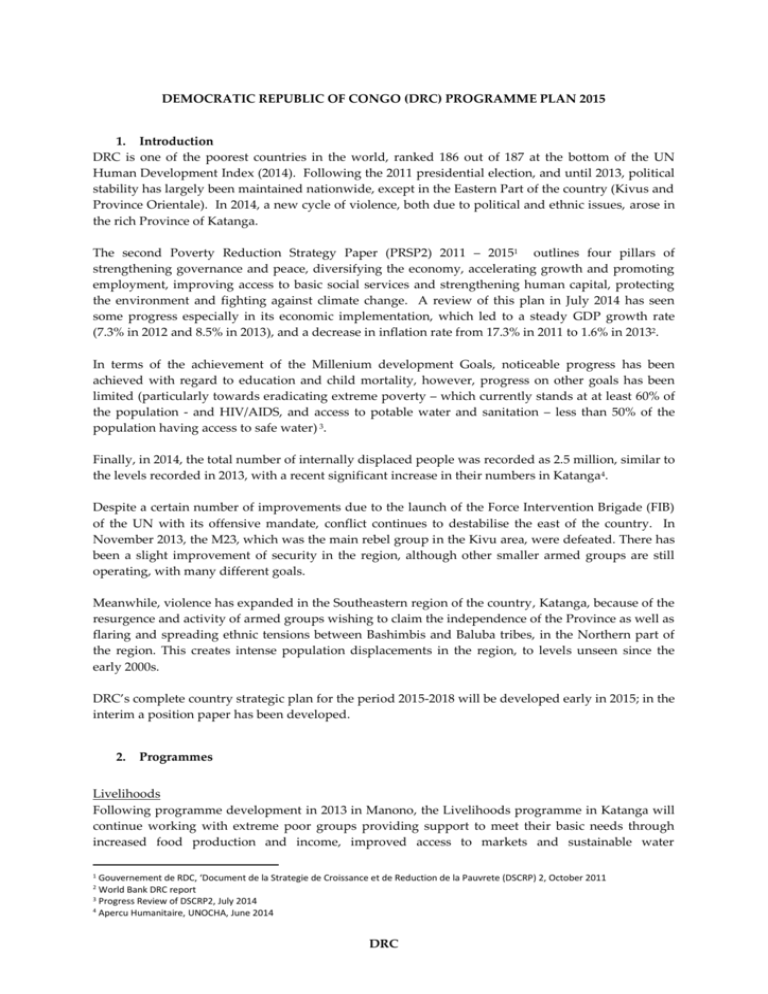
DEMOCRATIC REPUBLIC OF CONGO (DRC) PROGRAMME PLAN 2015 1. Introduction DRC is one of the poorest countries in the world, ranked 186 out of 187 at the bottom of the UN Human Development Index (2014). Following the 2011 presidential election, and until 2013, political stability has largely been maintained nationwide, except in the Eastern Part of the country (Kivus and Province Orientale). In 2014, a new cycle of violence, both due to political and ethnic issues, arose in the rich Province of Katanga. The second Poverty Reduction Strategy Paper (PRSP2) 2011 – 20151 outlines four pillars of strengthening governance and peace, diversifying the economy, accelerating growth and promoting employment, improving access to basic social services and strengthening human capital, protecting the environment and fighting against climate change. A review of this plan in July 2014 has seen some progress especially in its economic implementation, which led to a steady GDP growth rate (7.3% in 2012 and 8.5% in 2013), and a decrease in inflation rate from 17.3% in 2011 to 1.6% in 20132. In terms of the achievement of the Millenium development Goals, noticeable progress has been achieved with regard to education and child mortality, however, progress on other goals has been limited (particularly towards eradicating extreme poverty – which currently stands at at least 60% of the population - and HIV/AIDS, and access to potable water and sanitation – less than 50% of the population having access to safe water) 3. Finally, in 2014, the total number of internally displaced people was recorded as 2.5 million, similar to the levels recorded in 2013, with a recent significant increase in their numbers in Katanga4. Despite a certain number of improvements due to the launch of the Force Intervention Brigade (FIB) of the UN with its offensive mandate, conflict continues to destabilise the east of the country. In November 2013, the M23, which was the main rebel group in the Kivu area, were defeated. There has been a slight improvement of security in the region, although other smaller armed groups are still operating, with many different goals. Meanwhile, violence has expanded in the Southeastern region of the country, Katanga, because of the resurgence and activity of armed groups wishing to claim the independence of the Province as well as flaring and spreading ethnic tensions between Bashimbis and Baluba tribes, in the Northern part of the region. This creates intense population displacements in the region, to levels unseen since the early 2000s. DRC’s complete country strategic plan for the period 2015-2018 will be developed early in 2015; in the interim a position paper has been developed. 2. Programmes Livelihoods Following programme development in 2013 in Manono, the Livelihoods programme in Katanga will continue working with extreme poor groups providing support to meet their basic needs through increased food production and income, improved access to markets and sustainable water 1 Gouvernement de RDC, ‘Document de la Strategie de Croissance et de Reduction de la Pauvrete (DSCRP) 2, October 2011 World Bank DRC report 3 Progress Review of DSCRP2, July 2014 4 Apercu Humanitaire, UNOCHA, June 2014 2 DRC management systems. As the former conxtual analysis focused on Shamwana & Dubie, a new shorter contextual analysis of Manono will be carried out in 2015. Depending on this analysis agricultural production will be increased through better access to inputs through the organization of fairs and skills development on agricultural practice and land management. Livestock distribution has already started and will continue, which will enhance households’ access to productive assets. Market access and return on agricultural production will also be supported through provision of agro-processing equipment, promotion of market gardens and other income generating activities. A cash for work component, targeting road rehabilitation, will provide opportunity for increased income and enhance trading linkages. This will be complimented by a water and sanitation initiative in the same villages, as an integrated programme. This component intends to reduce mortality and morbidity that negatively affects household productivity. Levels of risk of health related shocks will be reduced through increased access to drinking water and mobilisation to improve hygiene and sanitation practices. Structural issues of inequality will also be considered within the programme with specific measures taken to increase the participation of women and marginalised groups (Bashimbis) in programme activities, in terms of both representation and level of influence and decision making. It is estimated that the livelihoods programme will reach approximately 12,000 beneficiaries over the course of 2015 in Katanga. In the Masisi area of North Kivu, an area of chronic instability, the population remain highly vulnerability to conflict related shocks. Despite a sustained need for emergency support for these populations, Concern is also striving to support households, particularly those in more settled communities, to increase their resilience in the longer term. Concern hopes to secure further funding to build on UNICEF ARCC programme to continue innovating and implementing this approach in newly stabilized areas. Health Concern is also the lead agency in a nationwide Consortium of five agencies, that will be working across five provinces of the country on a period of 4 years (2013-2017). The DRC WASH (Water Sanitation and Hygiene) Consortium addresses issues of mortality and morbidity by promoting sustained and improved access to potable water and sanitation facilities. In 2015, as part of the Consortium, Concern will work in 65 villages across two health zones of Manono territory. The programme emphasizes a community based approach, with establishment of management committees, community mobilisation and sensitisation on hygiene and sanitation promotion as a compliment to construction and rehabilitation of water supply points. This approach is also strengthening the capacities of local authorities and the linkages between Local, Provincial and National official WASH actors. Governance institutions and service providers will be supported to increase their capacity for WASH provision in the long term. It is estimated that the programme will reach 45,000 beneficiaries in the course of 2015. Additionnaly, the Consortium, through the CCU team present in Kinshasa, is also participating in national discussions on the WASH strategy for the country with other stakeholders, especially the Government, as this is one of the major challenge for its population, especially in rural areas, but also in semi-urban zones. The Consortium will also focus on sharing learning from the programme amongst stakeholders to inform activities in new target villages. Emergency DRC In 2015 Concern will continue to work with conflict affected populations in North Kivu, both in official camps and in communities, and through its programmes, is planning to reach at least 35,000 beneficiaries in the region. Based on significant programme experience in this region since 2008, Concern will continue to deliver a multi-sectoral package of assistance through voucher fairs and cash transfers to allow households to meet their basic needs and re-establish their productive asset base. Cash for work on the road infrastructure will provide additional income opportunities for households affected by the conflict while also contributing to improved access for humanitarian support. Newly displaced households in official camps will receive the standard non-food item support to replenish lost and looted materials. Concern will ensure that areas not yet targeted by previous programs are prioritized for these activities. Concern will also look into the possibilities to respond to needs created by the increasing displacements of population in Katanga. This will be done both through an adaptation of the current Concern longer term response in the area to take those displaced people into account, as well as in looking for additional funding to respond to specific and acute needs. 3. Monitoring and Evaluation Programme/project Timeframe Donors Timeline of M&E events Contexual Baseline Mid term Final analysis or endline review evaluation study FIM - Katanga 2012-16 Irish Aid Mar 2015 n/a Jul 2015 FIM – North Kivu 2013-15 UNICEF n/a Jan 2015 n/a n/a Health - WASH 2013-17 DFID n/a March Mar/Apr n/a 2015 (Wave 1) (Wave 3) August 2015 (Wave 2) Emergency – North Kivu 2014-15 Irish Aid, n/a OFDA DRC Jan 2015 n/a Aug 2015
